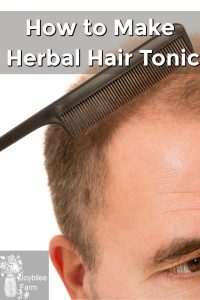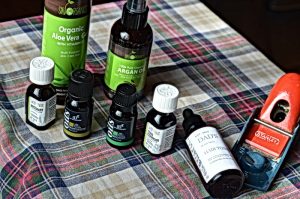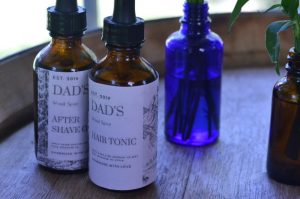Herbal Hair Tonic that Really Works
In January one of my readers asked me if I knew of an herbal remedy for baldness. I love it when a question from one of my readers inspires productive research. I found a scientific study that supports the use of herbal treatment with some forms of baldness or alopecia.
1998 Scottish study on hair loss treatment
A 1998 study at the Department of Dermatology, Aberdeen Royal Infirmary, Foresterhill, Aberdeen, Scotland, tested an essential oil treatment to see if it would help patients with hair loss caused by alopecia areata. [2]
Alopecia areata is an autoimmune skin disease where the immune system attacks a person’s hair follicles causing bald patches and sometimes causing complete hair loss. In alopecia areata, the hair follicles remain alive and can regrow. No one knows why some people get alopecia areata. It is estimated to affect 2 percent of the population.
The study used 4 essential oils because as whole herbs they have traditionally been used as hair tonics. Cedarwood Atlas, Lavender, Rosemary, and Thyme have been used to treat hair loss for over 100 years.
In this Scottish study, the essential oils were used with carrier oils. Patients self-administered the herbal hair loss treatment, massaging the essential oil treatment into the scalp for a minimum of 2 minutes.
“The active group received the essential oils: Thyme vulgaris (2 drops, 88 mg), Lavandula agustifolia (3 drops, 108 mg), Rosmarinus officinalis (3 drops, 114 mg), and Cedrus atlantica (2 drops, 94 mg). These oils were mixed in a carrier oil, which was a combination of jojoba, 3 mL, and grapeseed, 20 mL, oils.”[2]
Then they wrapped their heads in a warm towel to increase circulation to the scalp. In this double-blind study, 44% of those treated with the essential oils saw improvement in hair regrowth over a 7 month period. Some of the changes were dramatic, with both hair colour and growth being restored.
Would this essential oil treatment help other forms of baldness?
I wondered if the same essential oils would have a positive effect on other forms of hair loss, including age-related hair loss and male pattern baldness. At least, these essential oils can’t harm. So it was worth a try.
Instead of the carrier oils jojoba and grapeseed oil, I used aloe vera gel in my formula. The carrier oils used in the Scottish experiment would need to be shampooed out of the hair every day. The shampoo contains chemicals that are known to denature protein, like sodium laurel sulphate. Hair and skin are also made up of protein. Limiting the use of commercial shampoo is recommended for those with hair loss. [3]
Aloe vera, on the other hand, is known to re-establish the blood supply to tissue.[1] It also has been used traditionally for hair loss.
Aloe is anti-inflammatory and is used traditionally in creams and ointments to assist the healing of wounds, burns, eczema, and psoriasis. It has been found to increase collagen connectivity, increase circulation, and have an anti-bacterial action. [1] Aloe doesn’t need to be washed out of the hair. Some people use it as a styling gel.
My hair tonic has a 4% dilution of essential oils. The original formula has a 2% dilution of essential oils. I don’t know whether increasing the concentration of essential oils has any effect on the results, but I liked the scent.
You can make this hair tonic up in just a few minutes. Keep it in a silicone tube to make the application easy. When you run out just mix more.
Herbal Hair Tonic
Ingredients:
2 ounce Aloe Vera gel
16 drops Lavender essential oil
16 drops Rosemary essential oil
10 drops Thyme essential oil
10 drops Cedarwood Atlas essential oil
10 drops of Marjoram essential oil (see note)
4 drops Vitamin E, natural source (optional)
Directions:
Place the essential oils in a 60 ml silicone tube. I used this one. Add the organic aloe vera gel up to the collar of the bottle. Add the vitamin E. Replace the cap. I’ve made this both with and without vitamin e and I haven’t noticed any difference in the results. Shake well to evenly distribute the essential oils and vitamin E.
May be kept at room temperature. This bottle should last 2 weeks, with daily use on short hair. If you have longer hair it may be used up faster.
To use:
Place a small amount of aloe gel in the palm and massage it into the scalp. As you massage, don’t stress the hair follicles by rubbing the hair. Instead, press firmly on the scalp and move the scalp under the fingers. This will increase the circulation on the scalp without stressing the roots of the hair. Finish by rubbing the fingers gently through the hair to coat each strand. Repeat once daily.
If you are sensitive to aloe vera gel, feel free to try the original recipe used in the Scottish experiment with grapeseed oil and jojoba oil, instead of aloe vera gel.
If you are a sensitive individual, please test the formula in an inconspicuous spot before going forward with the recipe on your whole head. Allergies are not to be taken lightly. Do not use if you know you are allergic to any of the ingredients.
What’s with the Essential Oils?
Lavender – Analgesic, anticonvulsive, antimicrobial, anti-rheumatic, antiseptic, antispasmodic, antitoxic, carminative, cholagogue, choleretic, cytophylactic, deodorant, diuretic, emmenagogue, hypo-tensor, insecticide, nervine, parasiticide, rubefacient, sedative, stimulant, sudorific, tonic, vermifuge, vulnerary.[3]
Rosemary – Analgesic, antimicrobial, antioxidant, antiseptic, antispasmodic, astringent, carminative, choleretic, cicatrisant, cordial, diaphoretic, digestive, diuretic, emmenagogue, fungicidal, hepatic, hypertensor, restorative, rubefacient, stimulant, stomachic, sudorific, tonic. [3]
Thyme – Anthelmintic, antimicrobial, antioxidant, anti-rheumatic, antiseptic, antispasmodic, antitussive, antitoxic, astringents, bactericide, balsamic, carminative, cicatrisant, diuretic, emmenagogue, expectorant, fungicidal, hypertensive, nervine, rubefacient, stimulant, sudorific, aphrodisiac, tonic, vermifuge. [3]
Cedarwood Atlas – antiseptic, anti-putrescent, anti-seborrheic, astringent, diuretic, expectorant, fungicidal, mucolytic, sedative (to the nervous system), stimulant (to the circulatory system), tonic. [3]
Sweet Marjoram — antiseptic, antimicrobial, antioxidant, anti-inflammatory
This hair tonic will stimulate circulation in the scalp, especially if combined with massage. It is antimicrobial, anti-inflammatory and anti-oxidant.
On a preliminary trial here, it seemed to restore some natural colouring to grey hair, possibly because of its antioxidant action. It will not dye your hair. There is no colourant in this hair tonic.
Where to get essential oils?
I buy my essential oils from Mountain Rose Herbs, Plant Therapy, and Tropical Traditions.
Will it restore your hair?
I don’t know. But it won’t harm.
Mr. Joybilee has used this hair tonic for a year and has significant hair regrowth. It also restored his hair from grey to his natural red colour. Robin says his hair seems to be thicker, too. (I know that’s subjective. Maybe someone will fund a clinical trial!)
If you try it, let me know how it works for you.
![In this Scottish study the essential oils were used with carrier oils. Patients self-administered the herbal hair loss treatment, massaging the essential oil treatment into the scalp for a minimum of 2 minutes. “The active group received the essential oils: Thyme vulgaris (2 drops, 88 mg), Lavandula agustifolia (3 drops, 108 mg), Rosmarinus officinalis (3 drops, 114 mg), and Cedrus atlantica (2 drops, 94 mg). These oils were mixed in a carrier oil, which was a combination of jojoba, 3 mL, and grapeseed, 20 mL, oils.”[2] Then they wrapped their heads in a warm towel to increase circulation to the scalp. In this double blind study, 44% of those treated with the essential oils saw improvement in hair regrowth over a 7 month period.](https://g6c4m6d2.delivery.rocketcdn.me/wp-content/uploads/2016/02/Herbal-Hair-Tonic-lg.jpg)
Can I use this recipe on a child?
A child’s immature liver cannot clear essential oils from their body in the same way that an adult liver can. Essential oils should be diluted more for children. For a child between 3 years and 10 years of age dilute the essential oils by 1/4. Instead of using 16 drops of lavender, use only 4 drops. Instead of using 10 drops of thyme use only 2.
Also, young children develop allergies more readily than adults, so always test a small area of skin before proceeding with covering the head. If there is redness or rash after you apply it, change the formula to remove the ingredient that is causing sensitivity.
Do not use it on a child under 3. Keep all essential oils secure and away from children. Treat them as you would any other strong chemical. Even though they are natural they are highly concentrated and can pose a risk of poisoning.
Note: I am not trying to sell you anything. I don’t know what your result will be if you choose to make a batch of this recipe and try it on your own hair. I don’t sell the hair tonic. I’m sharing as a neighbour to a neighbour just as I would if you were in my kitchen, sharing a cup of tea with me. Please do your own research.
If you try it I’d love to know if it works for you.
Blessings,
Chris
References:
- Barnes, J., Anderson, L. A., & Phillipson, J. D. (2007). Herbal medicines. London: Pharmaceutical Press. p.48-51
- Hay, I. C., MRCP, Jamieson, M., SRN, & Ormerod, A. D., FRCP. (1998). Randomized Trial of Aromatherapy: Successful Treatment for Alopecia Areata. Arch Dermatology, 135(5), 602-603. Retrieved February 23, 2016, from http://archderm.jamanetwork.com/article.aspx?articleid=189618
- Lawless, J. (1998). The complete illustrated guide to aromatherapy: A practical approach to the use of essential oils for health and well-being. Shaftesbury, Dorset: Element.
I have a FREE gift for you

Grab my free ebook and learn to make DIY herbal healing salves at home now, with 14 easy to follow recipes that use the herbs and wild plants growing close to home. Salve making is one of the easiest skills to learn in DIY Herbalism.



![In this Scottish study the essential oils were used with carrier oils. Patients self-administered the herbal hair loss treatment, massaging the essential oil treatment into the scalp for a minimum of 2 minutes. “The active group received the essential oils: Thyme vulgaris (2 drops, 88 mg), Lavandula agustifolia (3 drops, 108 mg), Rosmarinus officinalis (3 drops, 114 mg), and Cedrus atlantica (2 drops, 94 mg). These oils were mixed in a carrier oil, which was a combination of jojoba, 3 mL, and grapeseed, 20 mL, oils.”[2] Then they wrapped their heads in a warm towel to increase circulation to the scalp. In this double blind study, 44% of those treated with the essential oils saw improvement in hair regrowth over a 7 month period.](https://g6c4m6d2.delivery.rocketcdn.me/wp-content/uploads/2016/02/hair-tonic-3.jpg)

![In this Scottish study the essential oils were used with carrier oils. Patients self-administered the herbal hair loss treatment, massaging the essential oil treatment into the scalp for a minimum of 2 minutes. “The active group received the essential oils: Thyme vulgaris (2 drops, 88 mg), Lavandula agustifolia (3 drops, 108 mg), Rosmarinus officinalis (3 drops, 114 mg), and Cedrus atlantica (2 drops, 94 mg). These oils were mixed in a carrier oil, which was a combination of jojoba, 3 mL, and grapeseed, 20 mL, oils.”[2] Then they wrapped their heads in a warm towel to increase circulation to the scalp. In this double blind study, 44% of those treated with the essential oils saw improvement in hair regrowth over a 7 month period.](https://g6c4m6d2.delivery.rocketcdn.me/wp-content/uploads/2016/02/hair-tonic2.jpg)



thank you very much for replie . So Can I use this for eyebrow ?